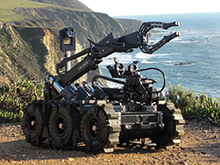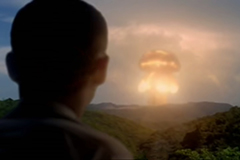1. How Nuclear Weapon Works:
Nuclear weapon bomb works by initiating a nuclear chain reaction, which releases a huge amount of energy relative to conventional explosives. Per unit volume, an atom bomb may be millions or billions of times more powerful than TNT. The first atomic explosion occurred on 16 July 1945 at the Alamogordo Test Range in New Mexico, during a test called Trinity. It was developed during the top secret Manhattan Project, which was directed by General Leslie R. Groves of the US Army. Nuclear weapons have been used twice in war, both times by the United States against Japan near the end of World War II. More details
The Mother of All Bombs (MOAB) or the GBU-43/B Massive Ordnance Air Blast is a large-yield conventional (non-nuclear) bomb, developed for the United States military by Albert L. Weimorts, Jr. of the Air Force Research Laboratory. At the time of development, it was touted as the most powerful non-nuclear weapon ever designed. The bomb was designed to be delivered by a C-130 Hercules, primarily the MC-130E Combat Talon I or MC-130H Combat Talon II variants. Since then, Russia has tested its "Father of All Bombs", which is claimed to be four times as powerful as the MOAB. More details
3. Bomb Disposal Robot History:
4. Joint Direct Attack Munition:
5. Incendiary Bombs:
6. GBU-39 Small Diameter Bomb:
7. Proximity Fuze:
8. Manhattan Project:
The Manhattan Project was a research and development undertaking during World War II that produced the first nuclear weapons. It was led by the United States with the support of the United Kingdom and Canada. From 1942 to 1946, the project was under the direction of Major General Leslie Groves of the U.S. Army Corps of Engineers. Nuclear physicist Robert Oppenheimer was the director of the Los Alamos Laboratory that designed the actual bombs. The Army component of the project was designated the Manhattan District; Manhattan gradually superseded the official codename, Development of Substitute Materials, for the entire project. More details
9. Tsar Bomba:
The Soviet RDS-202 hydrogen bomb, known by Western nations as Tsar Bomba was the most powerful nuclear weapon ever created. Tested on 30 October 1961 as an experimental verification of calculation principles and multi-stage thermonuclear weapon designs, it also remains the most powerful explosive ever detonated. The bomb was detonated at the Sukhoy Nos (Dry Nose) cape of Severny Island, Novaya Zemlya, 15 km (9.3 mi) from Mityushikha Bay, north of Matochkin Strait. The detonation was secret but was detected by US Intelligence agencies. More details
10. Bombing of Hiroshima:
The United States detonated two nuclear weapons over the Japanese cities of Hiroshima and Nagasaki on August 6 and 9, 1945, respectively, with the consent of the United Kingdom, as required by the Quebec Agreement. The two bombings killed between 129,000 and 226,000 people, most of whom were civilians, and remain the only use of nuclear weapons in armed conflict. In the final year of the war, the Allies prepared for a very costly invasion of the Japanese mainland. This undertaking was preceded by a conventional and firebombing campaign which devastated 67 Japanese cities. More details










